Chess Notes
Edward Winter
When contacting us by e-mail, correspondents are asked to include their name and full postal address and, when providing information, to quote exact book and magazine sources. The word ‘chess’ needs to appear in the subject-line or in the message itself.
| First column | << previous | Archives [169] | next >> | Current column |
10938. Correspondence between Capablanca and Prokofiev
Courtesy of the Butler Library of Columbia University, New York, the present item reproduces some correspondence between Capablanca and Prokofiev, forwarded to us by Olimpiu G. Urcan (Singapore):

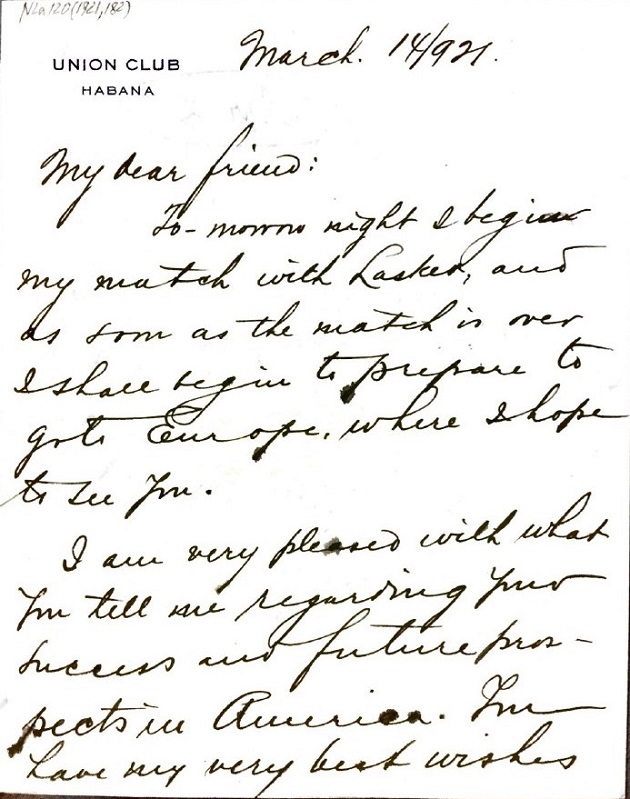

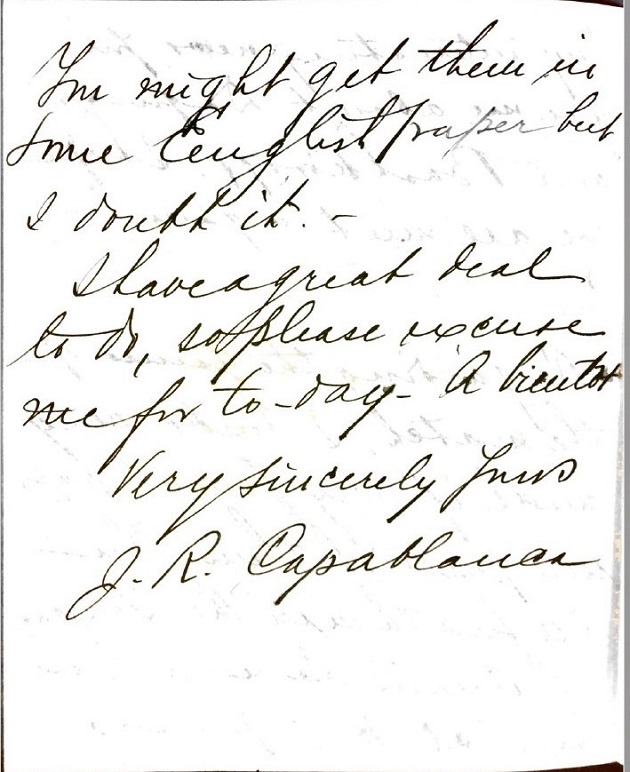

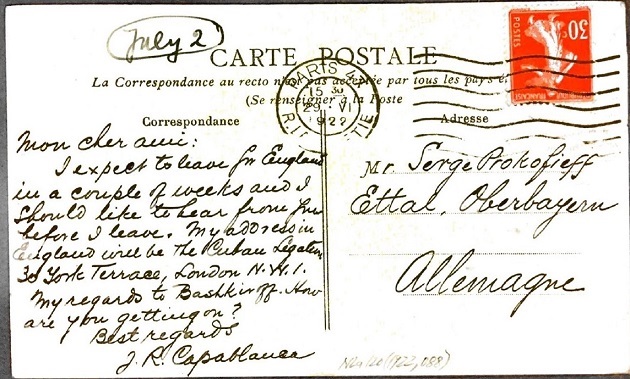
Further exchanges between Capablanca and Prokofiev will be presented shortly.
10939. Ulrich Geilmann
The first 45 pages of The Indian Chessmaster Malik Mir Sultan Khan by Ulrich Geilmann (Eltmann, 2018) have over a dozen illustrations of the master. Nearly all of them have been lifted, without permission or acknowledgement, from our feature article Sultan Khan.
10940. Neumann, Hirschfeld and Suhle
Just received: Neumann, Hirschfeld and Suhle by Hans Renette and Fabrizio Zavatarelli (Jefferson, 2018).
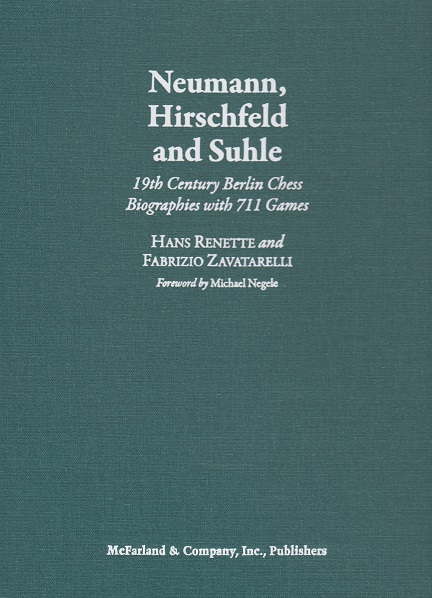
10941. A Bowl of Cherries (C.N. 10932)
Steve Wrinn (Homer, NY, USA) notes that the brief scene featuring Abe Turner in the film A Bowl of Cherries begins at about 10’32”.
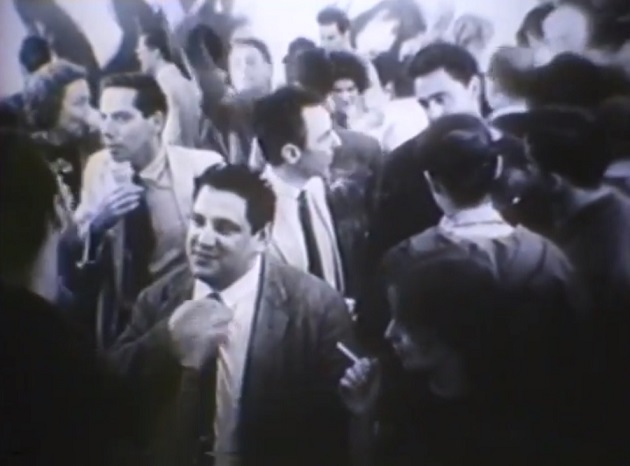
Abe Turner (left foreground)
10942. Multiple playing sessions
How many games of chess have gone to more than four playing sessions/sittings?
From page 341 of the Australasian Chess Review, December 1936:

10943. F.N. Jaynes (C.N. 10922)
Concerning Fremont N. Jaynes’ full name, yet to be established beyond doubt, Gerard Killoran (Ilkley, England) notes that ‘Fremont Nathan Jaynes’ appears in a non-chess report in column five of the St Paul Globe, 27 May 1899, page 8.
10944. Philipp Hirschfeld
C.N. 3 (see page 28 of Chess Explorations) mentioned that in Golombek’s Encyclopedia Wolfgang Heidenfeld described Hirschfeld as ‘probably the strongest player who never won anything’. A discussion of the matter on pages 86-87 of the new Renette/Zavatarelli book (C.N. 10940) concludes that Heidenfeld’s suggestion is ‘likely refuted’.
10945. Correspondence between Capablanca and Prokofiev (C.N. 10938)


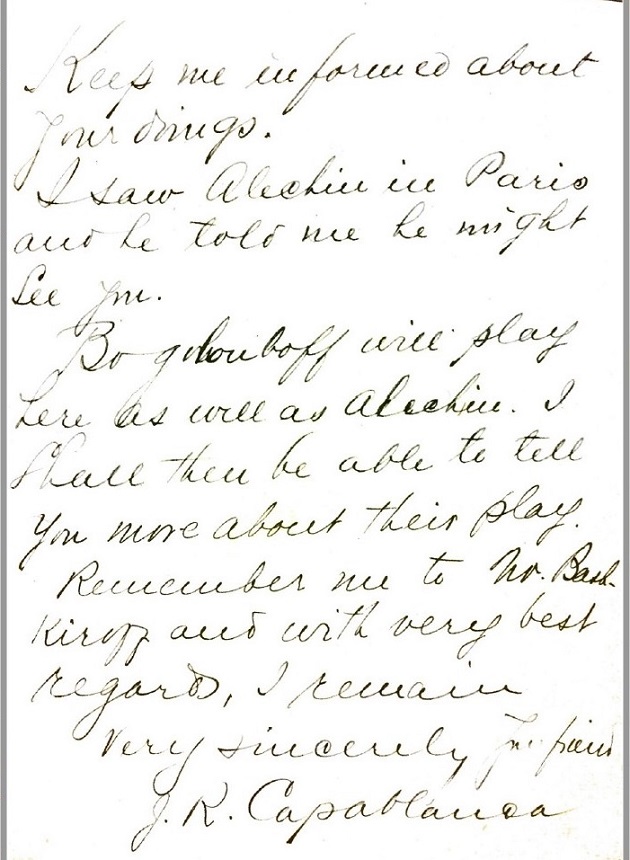
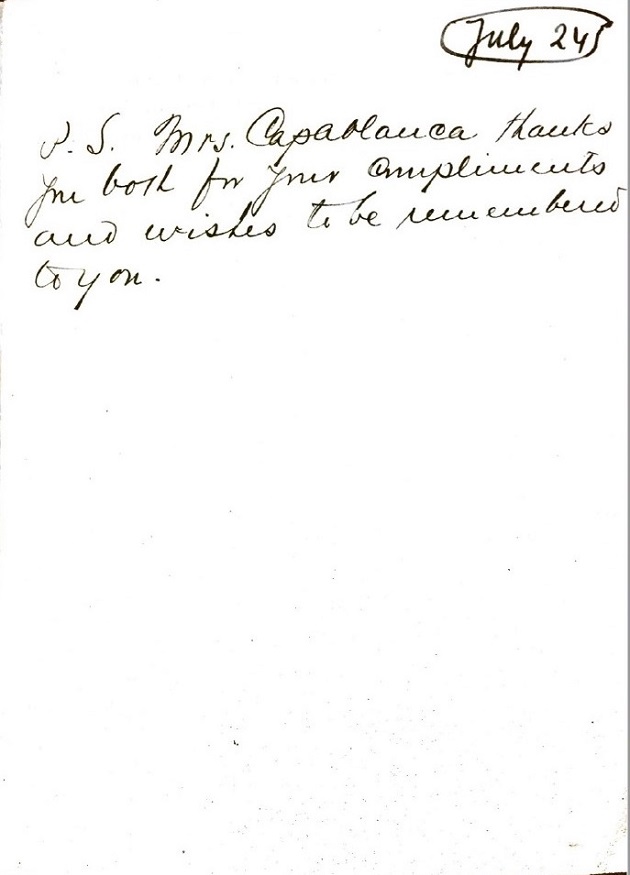
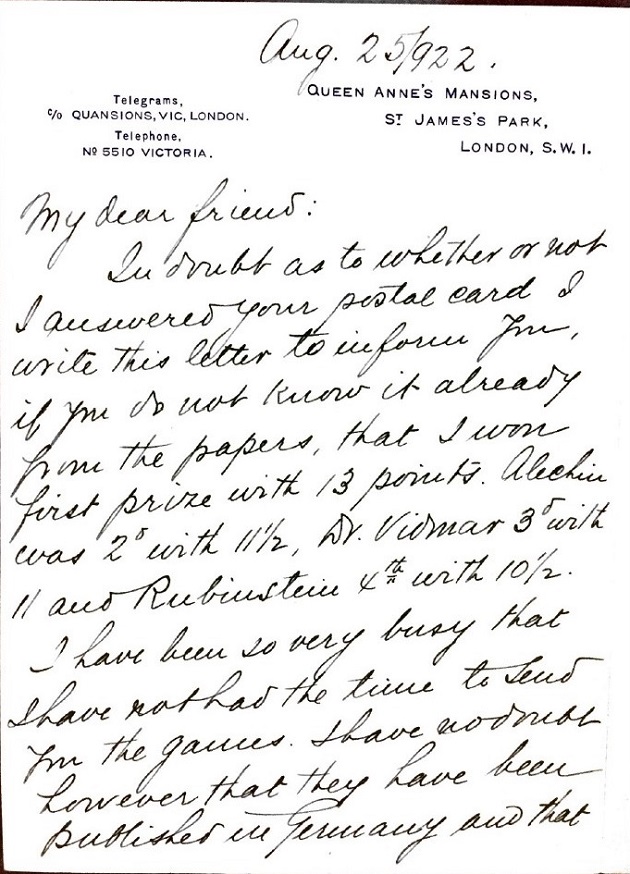
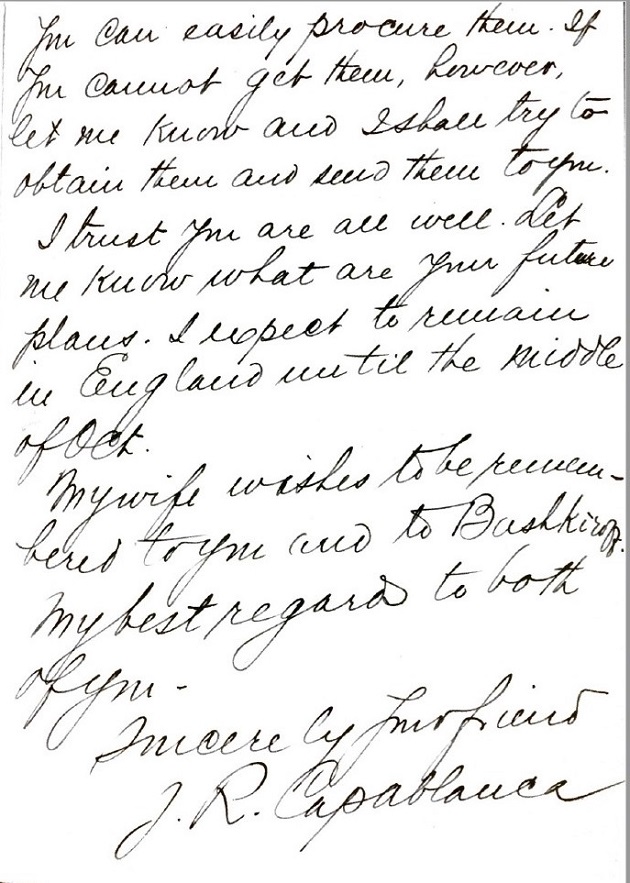
As mentioned in C.N. 10938, the correspondence has been provided to us by Olimpiu G. Urcan (Singapore), courtesy of the Butler Library of Columbia University, New York. Further items will follow.
10946. Bjelica and Alexander
Alan O’Brien (Mitcham, England) points out that the chart of world title match results shown in Copying (C.N. 6617) was lifted by Dimitrije Bjelica from a book by C.H.O’D. Alexander:
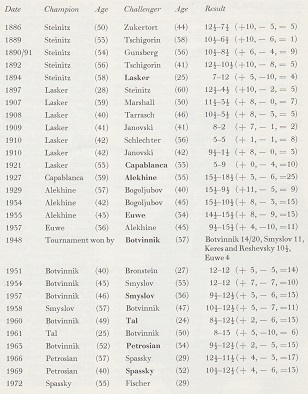
Fischer v. Spassky Reykjavik 1972 by C.H.O’D. Alexander (Harmondsworth, 1972), page 21
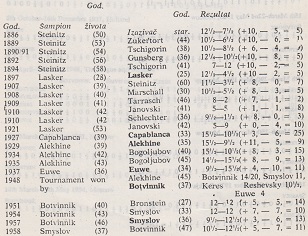

Kasparov protiv Karpova by D. Bjelica (Sarajevo, 1984), pages 234-235
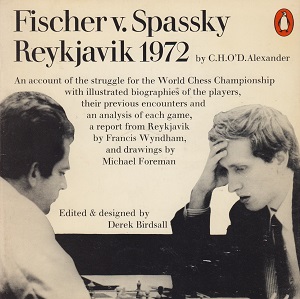
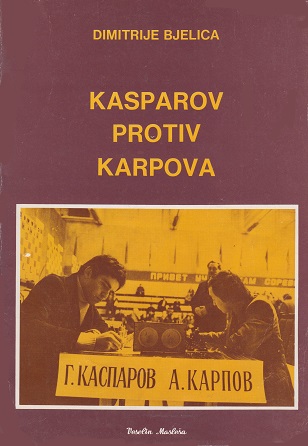
C.N. 9452 mentioned that copying usually goes hand-in-hand with incompetence, and it will be noted that misalignment on page 234 of Bjelica’s book resulted in a shambles:
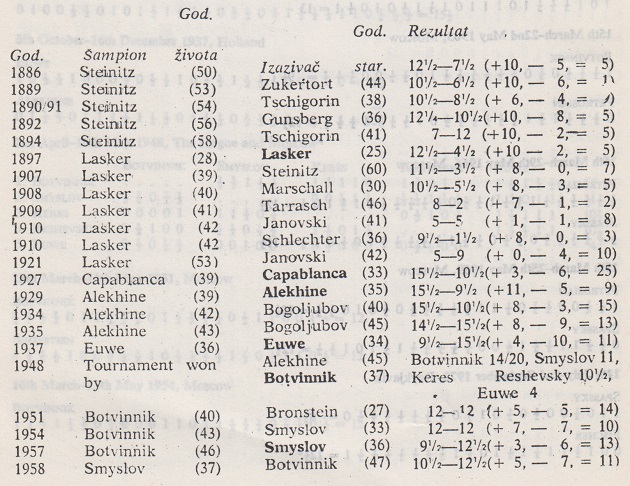
On page 20 of The Times, 22 April 1995 Bjelica was referred to as the Director of the International Chess Writers Association.
10947. Goldberg v Keres
From Dan Scoones (Port Coquitlam, BC, Canada) comes a Marshall Gambit game published on pages 2-3 of the 4/1976 issue of Shakhmaty Riga, in an article by Grigory Abramovich Goldberg:
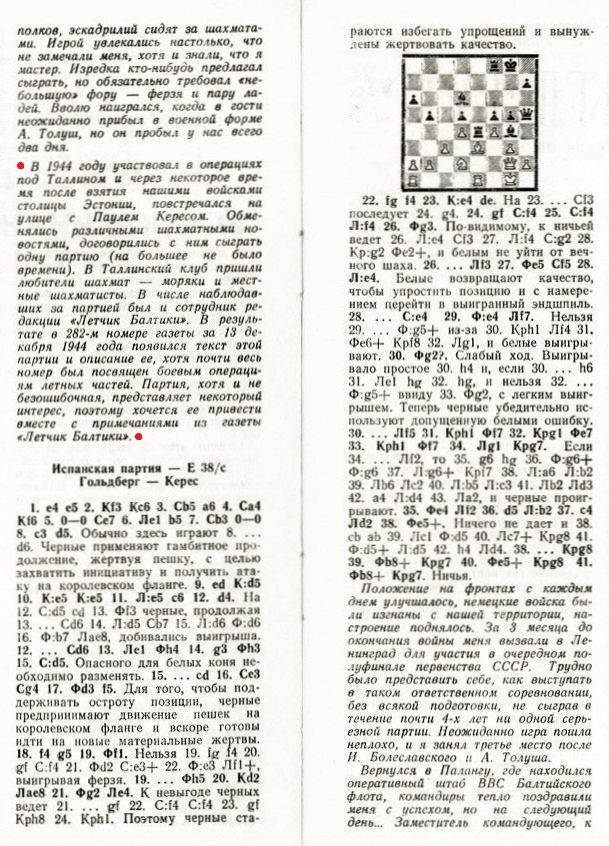
Our correspondent’s translation of the marked passage:
‘In 1944 I was taking part in military operations near Tallinn. A short time after our forces recaptured the city, I ran into Paul Keres in the street. We exchanged various pieces of news from the chess world and agreed to play a game (there was not time for more than one). This drew some chess aficionados to the Tallinn club, including sailors and local chessplayers. Among the spectators at this game was an editorial assistant of the newspaper Baltic Aviator. As a result, issue #282 for 13 December 1944 carried the text of the game and a short account of it, but of course most of the issue was concerned with military operations by our air forces. The game is not free of errors, but is still of some interest; I should therefore like to present it here, along with the comments from Baltic Aviator.’
1 e4 e5 2 Nf3 Nc6 3 Bb5 a6 4 Ba4 Nf6 5 O-O Be7 6 Re1 b5 7 Bb3 O-O 8 c3 d5 9 exd5 Nxd5 10 Nxe5 Nxe5 11 Rxe5 c6 12 d4 Bd6 13 Re1 Qh4 14 g3 Qh3 15 Bxd5 cxd5 16 Be3 Bg4 17 Qd3 f5 18 f4 g5 19 Qf1 Qh5 20 Nd2 Rae8 21 Qg2
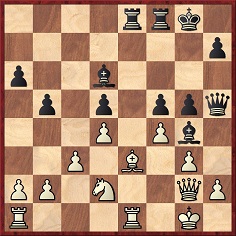
21...Re4 22 fxg5 f4 23 Nxe4 dxe4 24 gxf4 Bxf4 25 Bxf4 Rxf4 26 Qg3 Rf3 27 Qe5 Bf5 28 Rxe4 Bxe4 29 Qxe4 Rf7
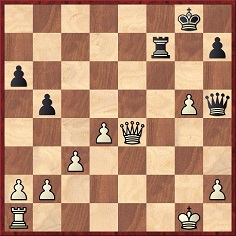
30 Qg2 Rf5 31 Kh1 Qf7 32 Kg1 Qe7 33 Kh1 Qf7 34 Rg1 Kg7 35 Qe4 Rf2 36 d5 Rxb2 37 c4 Rd2 38 Qe5+ Kg8 39 Qb8+ Kg7 40 Qe5+ Kg8 41 Qb8+ Kg7 Drawn.
10948. Marshall and Reshevsky
From page 8 of the Boston Globe, 22 November 1920:

10949. Emanuel Lasker and Shakespeare
Jean-Pierre Rhéaume (Montreal, Canada) points out that Lasker’s Manual of Chess ascribes the phrase ‘as cheap as blackberries’ to Hamlet (instead of Falstaff, in Henry IV Part I, act two, scene four – ‘if reasons were as plenty/plentiful as blackberries’). In the Manual page numbers vary from one edition to another; the reference is in the opening paragraph of the section entitled ‘The History of Planning in Chess’ in the Fourth Book. In German editions the text read ‘billig wie Brombeeren’, also with Hamlet mentioned incorrectly.
10950. Fischer and women (C.N. 10750)
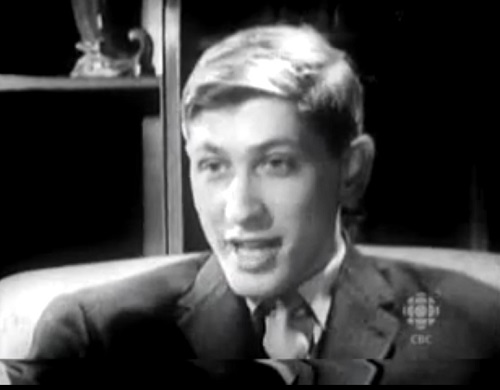
In C.N. 10750 an interview with Fischer on Canadian television was noted by Olimpiu G. Urcan (Singapore). Now, our correspondent has found this report on page 27 of the Montreal Gazette, 27 January 1962 [sic – not 1963 as indicated on the video page], which gives information on the transmission date and states that the interviewer was Bob Quintrell:
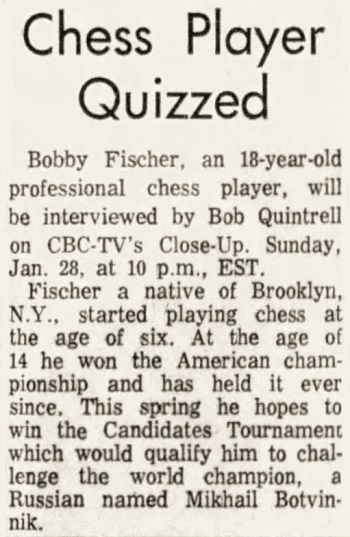
10951. A famous game revisited
A key position from a remarkable game:
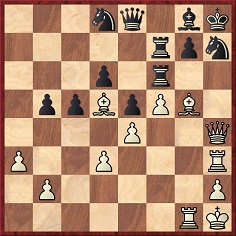
White to move
This is the first game in José Raúl Capablanca Sekrety masterstva by A. Bezgodov (Rostov-on-Don, 2018), with a bizarre heading on page 11:
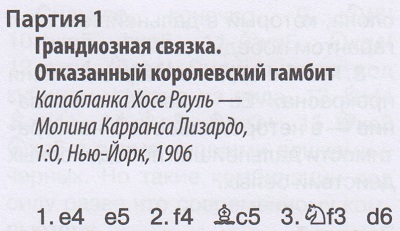
By what process can Buenos Aires, 1914 become New York, 1906? It was a consultation game, against Molina and Ruiz, played in the Argentinian capital on 17 September 1914; moreover, Capablanca’s first move was 1 f4 according to the Cuban himself, who annotated the game in his 1920 book My Chess Career.
The game has been highly praised. See, for example, Lessons in Chess Strategy by Cozens, The Unknown Capablanca by Hooper and Brandreth and The Golden Dozen by Chernev. In the diagrammed position, each book gave the Cuban’s move 30 b3 two exclamation marks, and Cozens remarked:
‘The white pieces, all of which are focused on the black king, have one forgotten and unsuspectedly powerful ally – the QRP! After 31 P-R4 a passed pawn must come into being on the far left, and its advance will create a deadly extra threat, which will be one too many for Black’s fully occupied defenders.’
In the previous note, after 29...Raf7, Cozens observed that ‘Black is approaching the state of affairs known as Zugzwang’, and Reinfeld used that term twice in his annotations in The Immortal Games of Capablanca.
Reinfeld’s introduction:
‘This game is characterized by some unusually fine combinative play, including some moves that must have been uncommonly difficult to discover. It is easy to foresee the brutal sacrifices and their sequel, but to make a sacrifice intuitively and follow it up unconcernedly with quiet waiting moves whose cumulative force finally crushes the enemy – that is consummate chess artistry.’
‘A very beautiful game, played to perfection throughout’, commented Hooper and Brandreth, although a computer check suggests several alternative wins (including 30 Bxf6, followed by 31 Rhg3). It would be interesting to see a strong master’s detailed annotations today.
Below is the game, ‘which I feel sure will please both the dilettante and the connoisseur’, as given by Capablanca in My Chess Career: 1 f4 e5 2 e4 Bc5 3 Nf3 d6 4 Nc3 Nc6 5 Na4 Bb6 6 Bb5 Bd7 7 Nxb6 axb6 8 d3 Nge7 9 O-O O-O 10 f5 f6 11 Bc4+ Kh8 12 a3 Be8 13 Be6 Bh5 14 Qe1 Qe8 15 Qh4 Nd8 16 Ba2 Bf7 17 c4 c5 18 g4 Ng8 19 Bd2 b5 20 g5 fxg5 21 Nxg5 Nf6 22 Rf3 bxc4 23 Nxh7 Nxh7 24 Rh3 Bg8 25 Bxc4 Rf7 26 Kh1 b5 27 Bd5 Raa7 28 Rg1 Rf6 29 Bg5 Raf7 30 b3 Qf8 31 a4 bxa4 32 bxa4 Qe8 33 a5 Nc6 34 a6 Nb4 35 Bxf6 Nxd5 36 Bxg7+ Rxg7 37 Rxg7 Kxg7 38 Qh6+ Kh8 39 Qxd6.

‘And after a few more moves Black resigned’, wrote Capablanca. Ignoring that, some writers have stated that the allies resigned on move 39. Whatever additional moves were played have yet to be traced.
The game is not in any of the issues of the Revista del Club Argentino de Ajedrez available to us, although pages 69-71 of the July-September issue had a general article by Enrique G. Ruiz on Capablanca’s stay in Argentina. It was reproduced on pages 423-424 of El Ajedrez en la Argentina by José Pérez Mendoza (Buenos Aires, 1920). The earliest appearance of the game that we can quote at present is on page 4 of part 5 of the Sunday Star (Washington, DC), 7 February 1915. The allies’ names were garbled, but Capablanca’s own notes were presented:

10952. Capablanca in Buffalo
From page 8 of the Buffalo Enquirer, 23 November 1909:
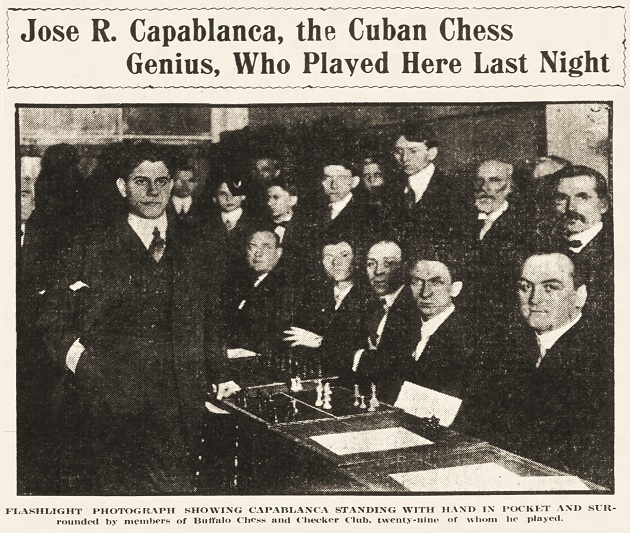
10953. Zollner v Heywood (C.N. 10871)
Lonnie Kwartler (Chester, NY, USA) reverts to the Zollner v Heywood game:
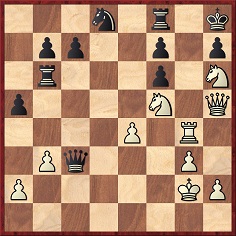
White to move
‘After 28 Qxf7 Nxf7 Black was mated on move 30, and C.N. 10871 showed that in 1976 a Chess Life & Review correspondent suggested the possibility of 28 Qxf7 Qd2+ with perpetual check since 29 Kh3 allows 29...Qxh6+. In reply, Larry Evans stated that 28 Qxf7 Qd2+ 29 Kf3 leads to perpetual check because 29... Qxh6 is refuted by 30 Qxc7.
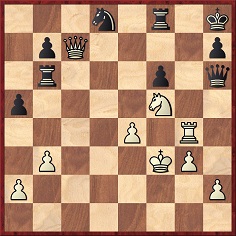
In that line, I suggest 30...Rc6 31 Qxd8 (31 Qxc6 Nxc6 32 Nxh6 Ne5+, and Black clearly stands better) 31...Rc3+ 32 Ke2 (32 Kg2 Rc2+ 33 Kf3 Rf2+ 34 Kxf2 Qxh2+ wins) 32...Qxh2+ wins. Instead of Evans’ 29 Kf3, 29 Kf1 Qxh6 30 Qe7 Re6 31 Qxc7 Qh3+ wins, and if 29 Kg1 Qxh6 30 Qxc7 Rc6 31 Qxc6 Qxh2+ 32 Kxh2 bxc6 33 Rg7 Rf7 34 Rxf7 Nxf7, and White stands somewhat better. After 29 Kg1 Black should play 29...Qe1+ 30 Kg2 Qe2+ (to cover g4) 31 Kg1, and Black has perpetual check. The other lines lose: 31 Kh3 Qxg4+ and 31 Kh1 Qf1 mate.’
10954. Editorial opinions
Editors of other people’s writing usually resist the temptation to barge in with their own opinions, and especially bare assertion, but Christian Rau (Rüsselsheim, Germany) points out this specimen from pages 109-110 of the third edition (Hollfeld, 1991) of Kurzgeschichten um Schachfiguren by Kurt Richter, edited by Godehard Murkisch:


10955. Hastings, 1895 (C.N. 9957)
Nick Pope (Ann Arbor, MI, USA) notes that a version of the picture referred to in C.N. 9957 is on page 21 of the Brooklyn Daily Eagle, 22 September 1895, with the players identified as Lasker and Pillsbury.
10956. Talk of a Botvinnik v Fischer match
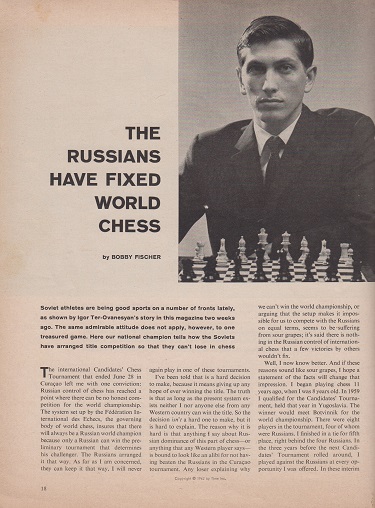
Pages 18-19 and 64-65 of Sports Illustrated, 20 August 1962 published an article by Bobby Fischer, ‘The Russians Have Fixed World Chess’, and one passage is shown below, from page 19:
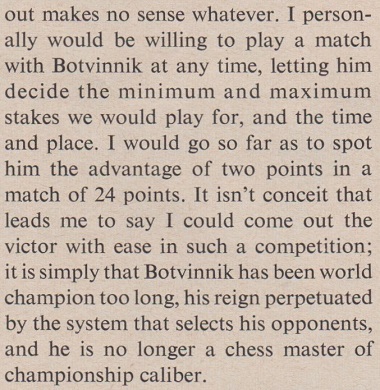
On page 66 of Profile of a Prodigy by Frank Brady (New York, 1973) the article was referred to in a section about the Olympiad in Varna later in 1962:

That second initiative was mentioned on page 21 of CHESS, 24 November 1962:
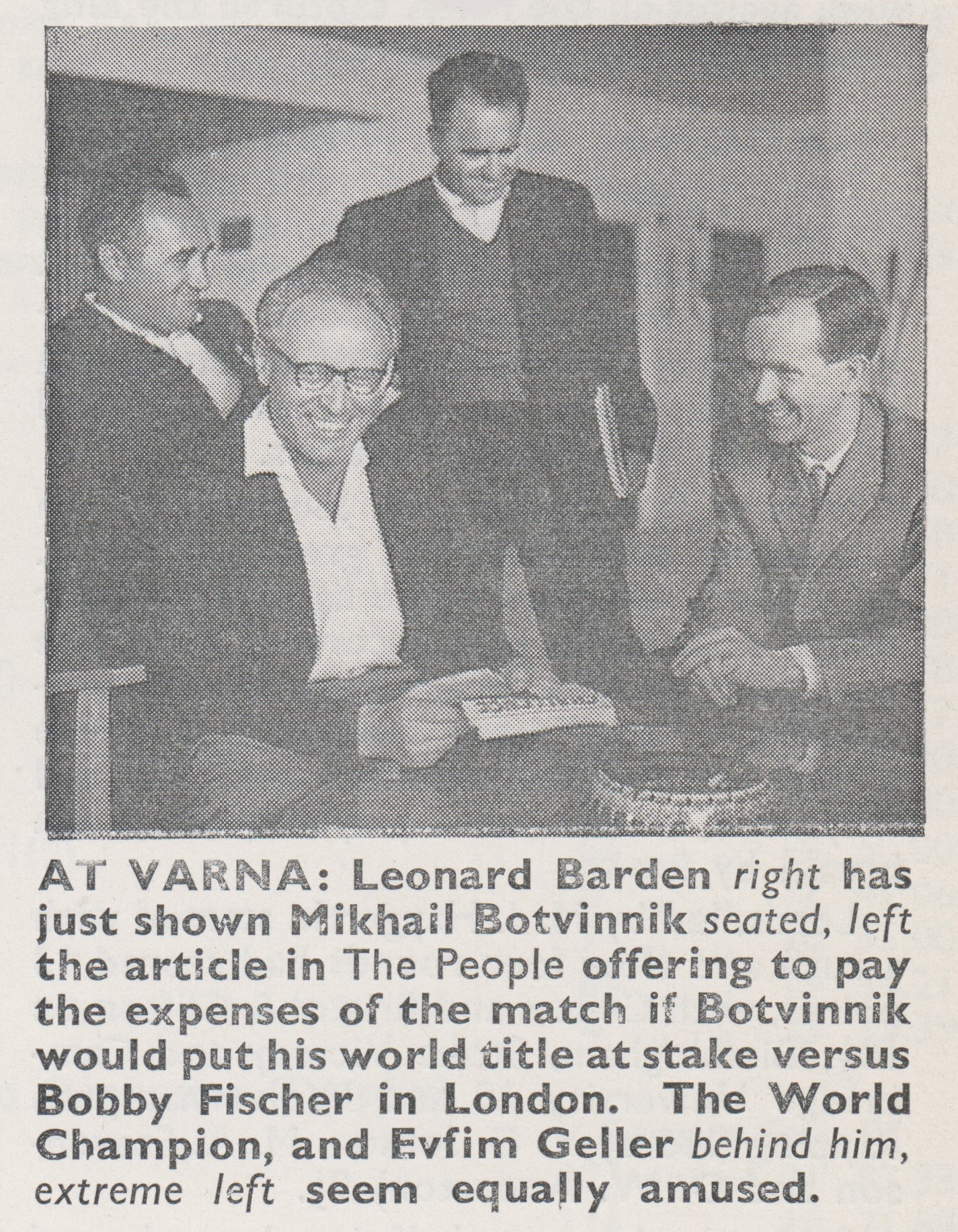
Can any reader supply the People article?
10957. Correspondence between Capablanca and Prokofiev (C.N.s 10938 & 10945)
The series, presented courtesy of the Butler Library of Columbia University, New York, which provided the material to Olimpiu G. Urcan (Singapore), is continued below:
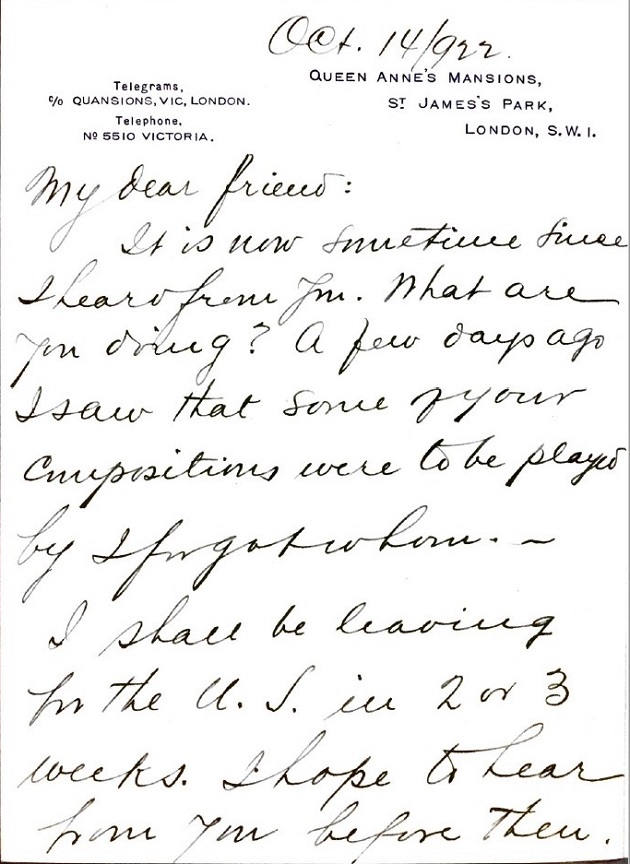
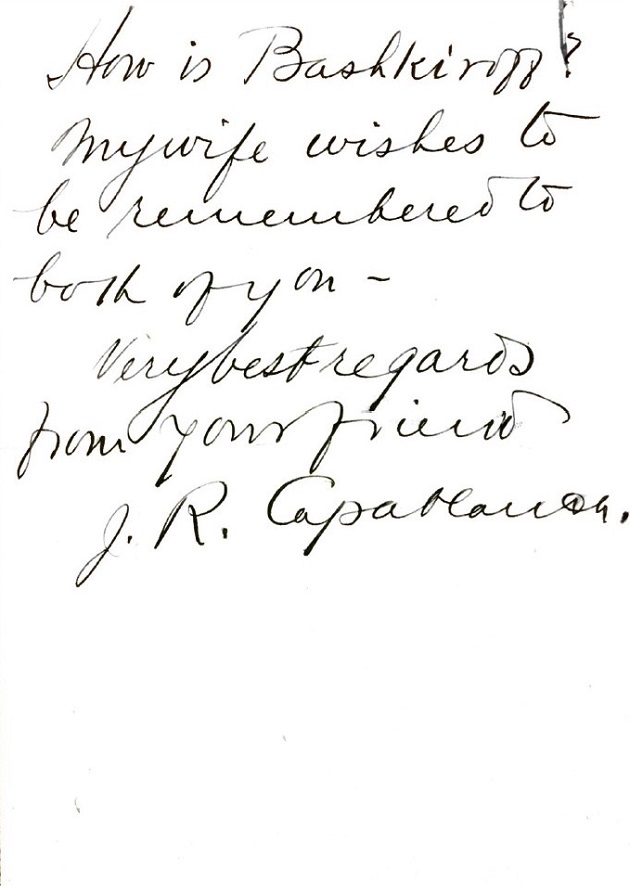
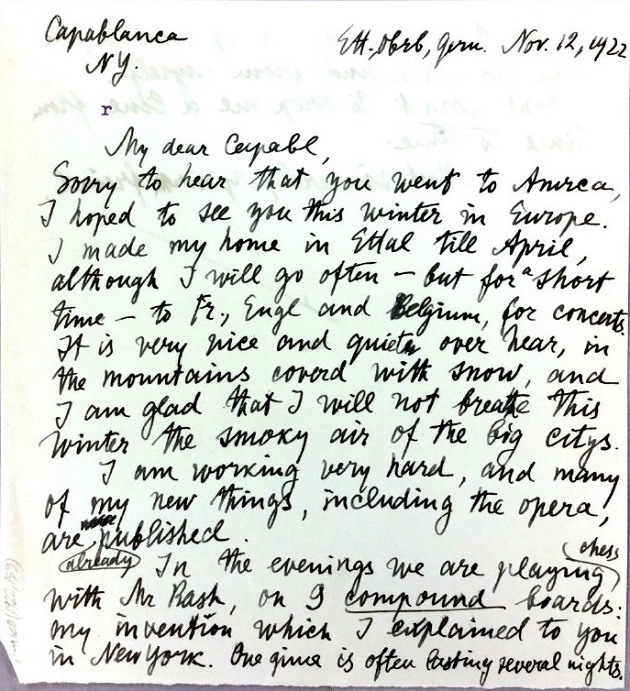
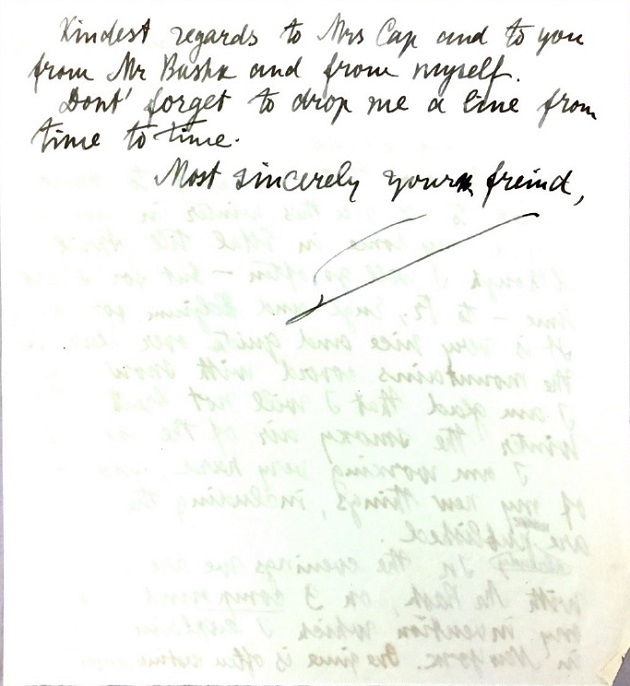
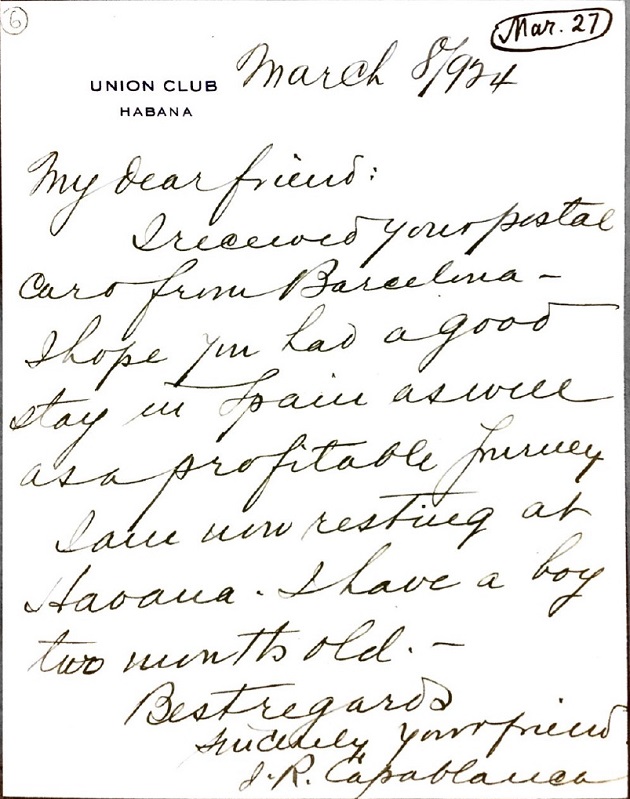
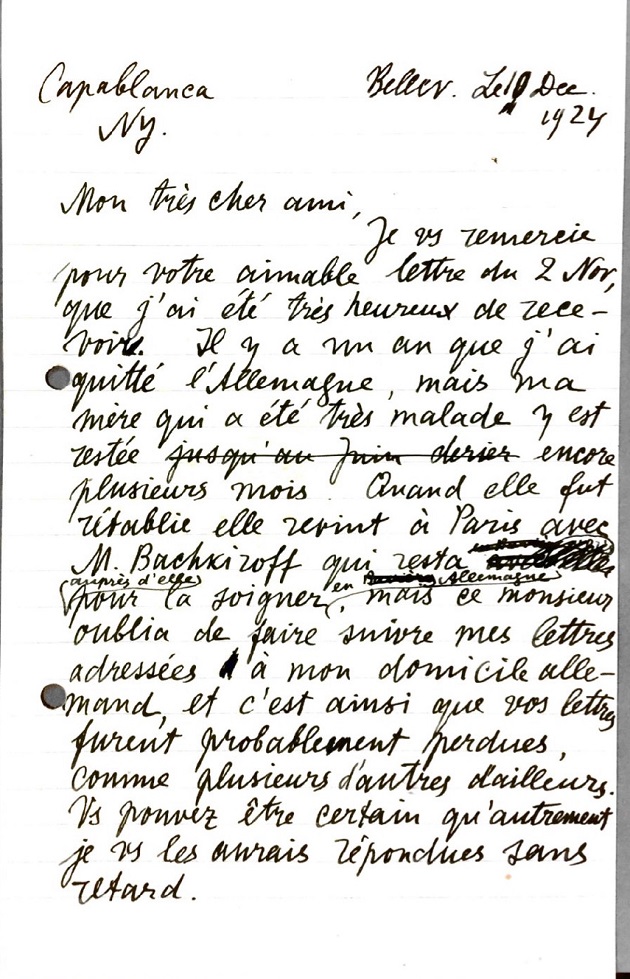

10958. Bobby Fischer and Henry Kissinger
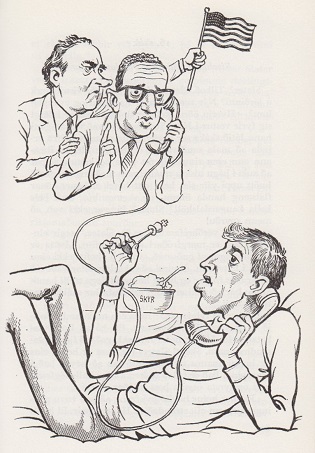
The above cartoon was shown in C.N. 9762, from page 103 of Skákeinvígi aldarinnar by Guðmundur Daníelsson (Reykjavik, 1972).
Ian Tregillis (Santa Fe, NM, USA) has been reviewing accounts of the contact between Bobby Fischer and Henry Kissinger in connection with the Spassky v Fischer world title match:
‘Kissinger himself, in the transcript of a telephone conversation with Jerry Schecter of Time on 21 July 1972, stated:
“I made only one call. I made it the day the parts [sic – departure?] for Iceland was in doubt and you know I did it as sort of being interested in chess.”
This suggests a call placed during Fischer’s stay in the Saidy household, which was approximately 30 June-3 July 1972. Kissinger’s conversation with Schecter took place roughly between games five and six of the match.
The following was the opening paragraph of an article ‘The Battle of the Brains’ by Ray Kennedy on page 32 of Time, 31 July 1972 (C.N. 5559):
From page 233 of Profile of a Prodigy by Frank Brady (New York, 1973), in connection with Fischer’s eventual decision to leave for Iceland:
“Later, it was learned that Henry Kissinger, Nixon’s presidential adviser, had called Fischer and appealed to him to play to avoid insulting the Icelandic nation.”
On page 184 of Endgame (New York, 2011) Brady wrote that Anthony Saidy himself answered the telephone when Kissinger's secretary called to set up a conversation with Fischer. Brady’s endnotes (page 358) cite a telegram from the American embassy in Reykjavik to the US Department of State, seeking White House assistance in having Fischer leave for Iceland. On page 184 Brady included the famous line allegedly spoken by Kissinger:
“This is the worst chessplayer in the world calling the best chessplayer in the world.”
In autumn 2017 I corresponded with Carla Braswell, an archivist at the Richard Nixon Presidential Library and Museum, where many of Kissinger’s telephone transcripts of the period are kept. Dr Braswell searched all records for July 1972 and found no mention of Fischer. She stated that it was possible, although in her opinion unlikely, that the transcript exists in Kissinger’s donated papers at either Yale University or the Library of Congress. That remains to be verified. She also pointed out that not all of Kissinger’s calls were recorded and transcribed, but the omission strikes me as peculiar, because that call to Fischer appears to have taken place after another call by Kissinger for which a transcript does exist: a conversation with David Frost. A publicly known transcript corroborates the Kissinger/Frost call at 10.45 on 3 July 1972. In addition, the archivists at the Nixon Library provided me with an unredacted version.
In that conversation with David Frost, Kissinger said, “I’ll do it”. That was only a few hours before Fischer was due to catch an overnight flight to Reykjavik.
Later, in the wake of Fischer’s forfeiture of the second match-game, matters become even cloudier.
From page 248 of Profile of a Prodigy:
“Fischer began receiving letters and cables – thousands according to Cramer – urging him to continue the match, and presidential adviser Henry Kissinger called him from Washington [my emphasis] to appeal to his patriotic interests in playing for the United States.”
A statement by Fred Cramer dated 17 July 1972 was reported briefly on page 21 of the New York Times the following day (“Kissinger Phone Call To Fischer Disclosed”). The Times item, which had a Reykjavik byline, suggested that a call had been made by Kissinger to Fischer in the Icelandic capital:
“Fred Cramer, a spokesman for Bobby Fischer, said today that Henry L. [sic] Kissinger had telephoned the American chess star here.
Mr Cramer, a vice president of the United States Chess Federation, would give no details of the call. He would not say when it had been made or what had been said.
It is believed, however, that Mr Kissinger, President Nixon’s closest adviser on foreign policy, had urged Fischer – who had threatened to walk out on the world championship chess match with the titleholder, Boris Spassky of the Soviet Union, to continue with the match.”
Page 194 of Endgame states that in the wake of Fischer’s forfeiture of the second game of the match, and his implied threat to abandon the match, “... Henry Kissinger called him once again, this time from California [again, emphasis mine] ...”
Were there definitely two calls from Kissinger to Fischer, and what more is known for certain?’
Finally for now, in the 1972 bound volume of Chess Life & Review we note two references to Henry Kissinger:
‘Slater announced that he was personally doubling the $125,000 purse. A certain Kissinger from the White House phoned – he would call again in a later crisis.’ (Anthony Saidy, November issue, page 679.)
‘With the score 2-0 against him, nobody expected Bobby to continue the match which he had been so reluctant to enter in the first place. But a massive telegram campaign, a phone call from presidential advisor Henry Kissinger, and redoubled efforts by his friends and advisors here [in Reykjavik], made him change his mind and cancel his plane reservations home.’ (Robert Byrne, September issue, page 537.)
10959. Misattribution
Who wrote the following?
‘A recorded game of chess is a story in symbols, relating in cipher the struggle of two intellects; a story with a real plot, a beginning, a middle, and an end, in which the harmonies of time and place are scrupulously observed; the fickleness of fortune is illustrated; the smiles of the prosperous, the struggles of adversity, the change that comes over the two; the plans suggested by one, spoiled by the tactics of the other – the lures, the wiles, the fierce onset, the final victory. An hour’s history of two minds is well told in a game of chess.’
A casual search on the Internet suggests Capablanca, but that is a misattribution resulting from the same faulty assumption discussed in Chess: the Need for Sources with regard to the ‘conferred sight’ remark.
C.N. 3741 showed pages 112-113 of The Bright Side of Chess by Irving Chernev (Philadelphia, 1948):
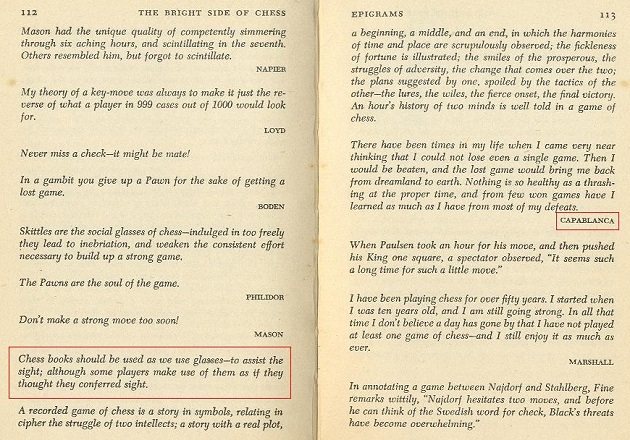
Only the passage beginning ‘There have been times in my life ...’ was written by Capablanca (in My Chess Career). In C.N. 4209 Michael Clapham (Ipswich, England) reported that he had found the ‘Chess books should be used ...’ observation on page 139 of The Chess-Player’s Annual for the Year 1856 edited by Charles Tomlinson (London, 1856).
The second quote of the three, beginning ‘A recorded game of chess ...’, is from page 74 of the same Tomlinson book, and the relevant page is reproduced below, courtesy of Mr Clapham:

Textual differences: the spellings cypher/cipher and the punctuation after ‘prosperous’ and ‘adversity’.
10960. Hastings, 1922
C.N. 10945 showed a letter from Capablanca to Prokofiev which began as follows:
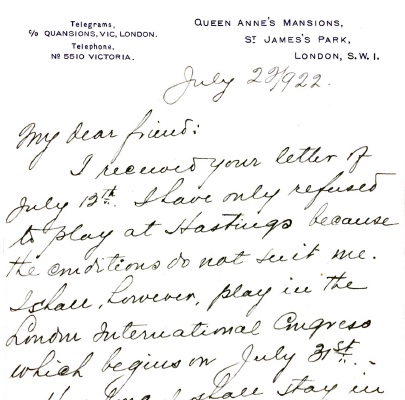
The first paragraph of W.H. Watts’ ‘General Account of the Tournament’ in the Hastings, 1922 book by Alekhine:
‘During the early days of the London International Tournament of 1922 it was rumoured that the energetic Hastings Club were organizing a Masters’ Tournament. It was hoped that the participation of both Capablanca and Lasker would be secured, but first one and then the other dropped out for reasons it is unnecessary to go into here.’
In fact, plans for a tournament in Hastings involving Capablanca, Lasker, Alekhine and Rubinstein were in the public domain well before London, 1922 began. Page 257 of the June 1922 Chess Amateur carried a report from the Morning Post that the plan ‘aims at no less than a World Champions’ tournament. The present and past champions and the two candidates for the title ...’:

From page 9 of the 20 May 1922 edition of the Hastings and St Leonards Observer:

Capablanca’s refusal to participate was explained in detail in a letter published on page 7 of The Times, 26 May 1922, which is on page 120 of our book on the Cuban.
10961. Alekhine and the openings
‘Alekhine is no believer in book knowledge, and prefers to adopt lines of his own.’
Source: BCM, October 1922, page 391, in a review of the London, 1922 tournament.
10962. Ghosts (C.N. 3229)

Jonathan Mestel (London) comments on C.N. 3229 (see Chess and Ghosts):
‘At the request of the publisher, I composed the game which accompanies the story and tried to choose moves which reflected the narrative, and in particular the smothering of the white queen and the inevitable consequences of her death. The playful but lethal jumping nature of the knights driving the black king around had a kind of poltergeist ring to me. The dénouement with the black king and queen displaced by the knights was also symbolic of the ending.’

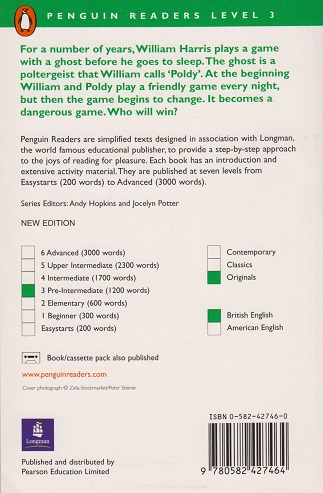
10963. Universities’ cable match
From page 8 of the Boston Globe, 26 April 1902:
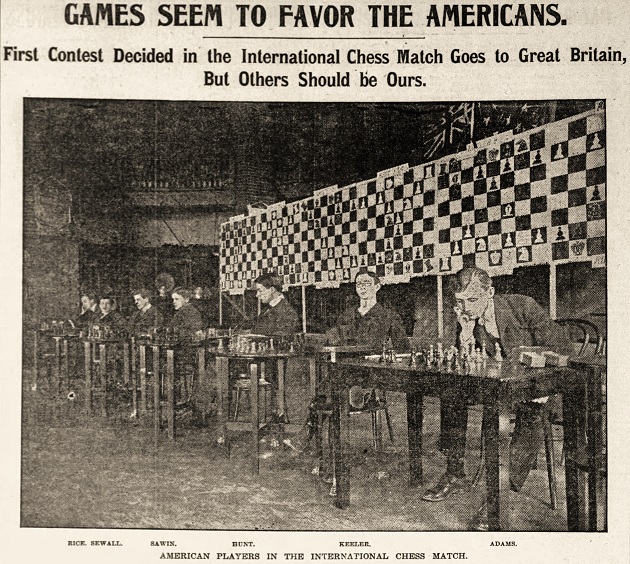
The result was published on page 228 of the May 1902 BCM:
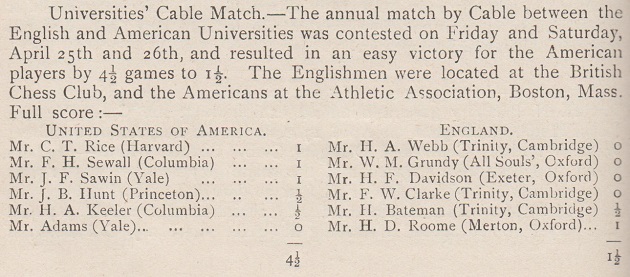
10964. Zollner v Heywood (C.N.s 10871 & 10953)
Timothy Stapay (Joliet, IL, USA) notes that after 27...Qc1xc3, instead of 28 Qxf7 White can force a quick mate by 28 Rg7, with Nxf7+ to follow.

10965. Nineteenth-century portraits (C.N. 3478)
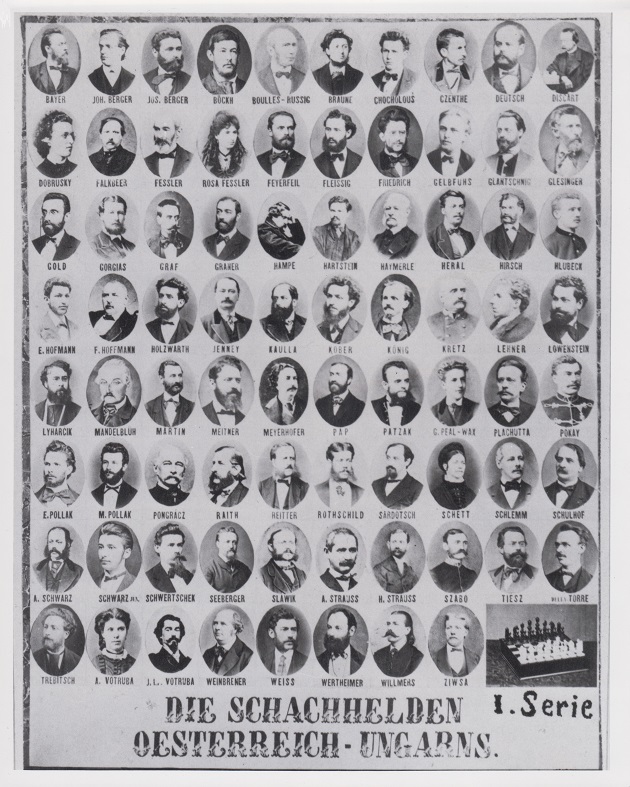
From Fabrizio Zavatarelli (Milan, Italy):
‘The image in C.N. 3478 is not dated, but on page 8 of Wiener Salonblatt, 15 April 1876 it is mentioned as a production sold to several correspondents at 1 Gulden and 15 cents in Austrian currency. (An issue of the magazine cost 20 cents.) The chess column at that time was edited by Samuel Gold.’
10966. Camille Moriau (C.N. 9441)
A blindfold game from pages 102-103 of La Stratégie, 15 April 1893:

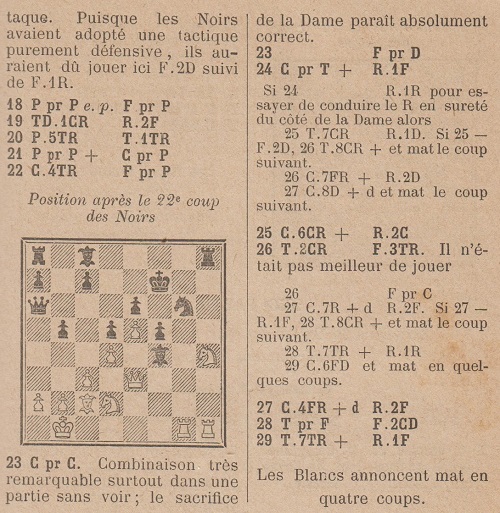
1 e4 e6 2 d4 d6 3 Bd3 g6 4 f4 Bg7 5 Nf3 Nc6 6 c3 Nge7 7 Be3 O-O 8 Nbd2 Qe8 9 Qe2 d5 10 e5 Nf5 11 O-O-O Nxe3 12 Qxe3 Ne7 13 g4 f5 14 g5 Qa4 15 Kb1 b5 16 Bc2 Qa6 17 h4 h5 18 gxh6 Bxh6 19 Rdg1 Kf7 20 h5 Rh8 21 hxg6+ Nxg6 22 Nh4 Bxf4 23 Nxg6 Bxe3 24 Nxh8+ Kf8 25 Ng6+ Kg7 26 Rg2 Bh6 27 Nf4+ Kf7 28 Rxh6 Bb7 29 Rh7+ Kf8, and White announced mate in four moves.
10967. W.H. Cozens and J.R. Schroeder
In correspondence with W.H. Cozens in the 1970s we criticized a book(let) by James Schroeder, and (as reported in C.N. 2640) on 29 January 1975 Cozens replied:
‘I was amused (and, uncharitably, rather pleased) at all you had to say about Mr James Schroeder. Soon after the publication of my Spassky’s Road to the Summit in 1966 the BCM sent me a copy of a really vicious review of it, by our Mr Schroeder. We were amused and also puzzled by it, until we discovered the reason: he was himself about to bring out a book of Spassky’s games and he resented us getting in ahead of him. When his book appeared (I forget the exact title) the BCM sportingly asked me to review it and I thought “the Lord hath delivered him into my hand”. But when I saw the book it was so laughable that I refused to review it. To do so would have been a waste of BCM space and readers’ time. If you have found a book worse than that one it must really be something.’
We own Cozens’ copy of Schroeder’s volume, Boris Spassky World’s Greatest Chess Player (Cleveland, 1967):

Does a reader have Schroeder’s review of Spassky’s Road to the Summit?
10968. White to move
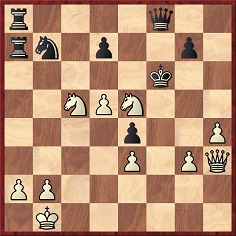
There are many ways to win, but only one move gives mate in three.
The position is discussed in our latest feature article.
10969. Correspondence between Capablanca and Prokofiev (C.N.s 10938, 10945 & 10957)
The final batch of exchanges:
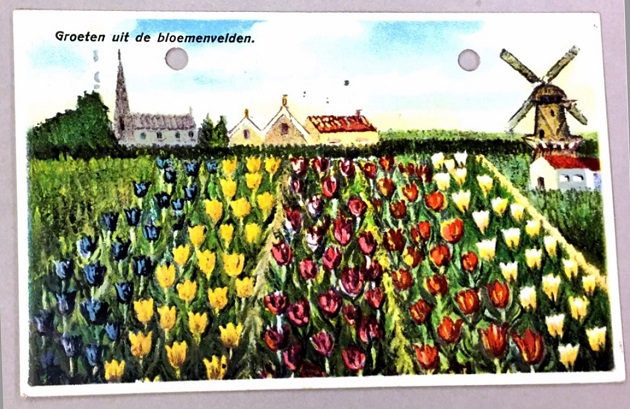


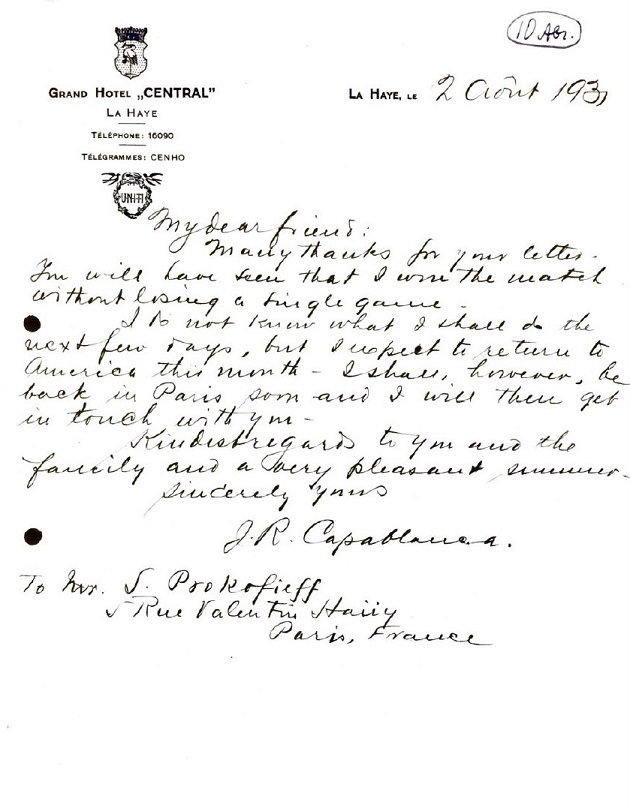
As acknowledged in the three earlier items, the correspondence has been reproduced here courtesy of the Butler Library of Columbia University, New York, which supplied it to Olimpiu G. Urcan (Singapore).
10970. Chess and women
The feature article Chess and Women has not yet mentioned a ‘discussion’ – in the stretched sense of the term – in CHESS in 1973. It began on pages 226-227 of the May issue when, under the title ‘The geese save Rome but women don’t play chess as well as men’, Dimtrije Bjelica listed many masters’ alleged replies to his question ‘Why do women play worse chess than men?’ A lowlight of the ensuing ‘debate’ – another stretch – was a letter from R. Hughes-Hallett on pages 261-262 of the June 1973 CHESS:
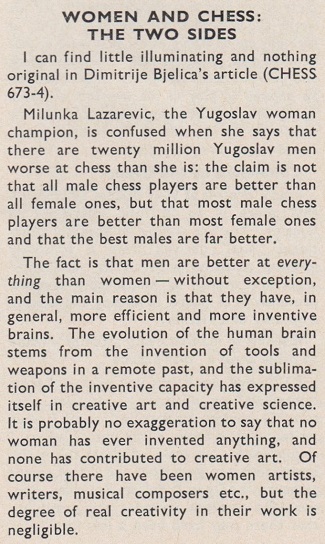

10971. General amusement

Source: CHESS, September 1973, page 351.
The occasion was a tournament in Enfield, organized by Penn and won by Hartston.
10972. A.B. Hodges’ father-in-law
John S. Hilbert (Amherst, NY, USA) sends this cutting from page 1 of the 22 December 1899 edition of the New York Tribune, found by Jerry Spinrad:
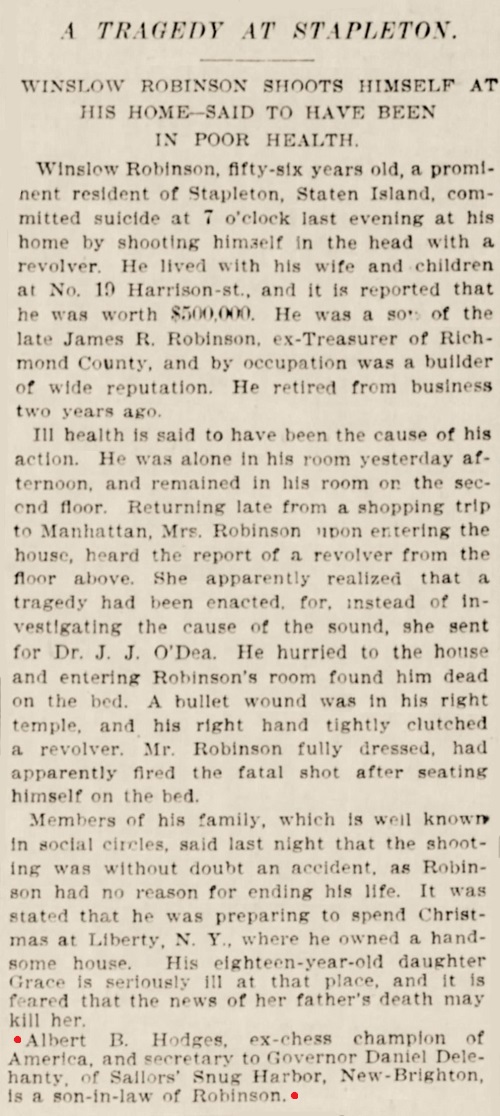
Dr Hilbert comments:
‘I did not run across the information years ago when writing the Hodges book. It gives a somewhat different cast to Hodges’ social status compared to what I had imagined.’
The Hodges work was published by McFarland & Company, Inc. in 2008 (hardback) and 2013 (paperback).

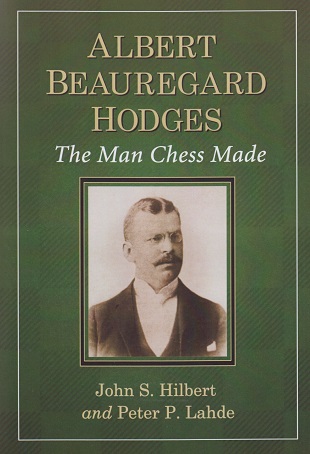
10973. Chielamangus
‘The player who completes his development first is said to have the initiative, because he is thus able to start making blunders while his opponent is still occupied in bringing out his men.’
That remark from page 14 of “Among These Mates” by Chielamangus (Sydney, 1939) was given in C.N. 1858 (see page 246 of Chess Explorations).
A modern alternative:
‘The player who completes his or her development first is said to have the initiative, because he or she is thus able to start making blunders while his or her opponent is still occupied in bringing out his or her men or women.’
The text on pages 12-15 of Purdy’s pseudonymous book:
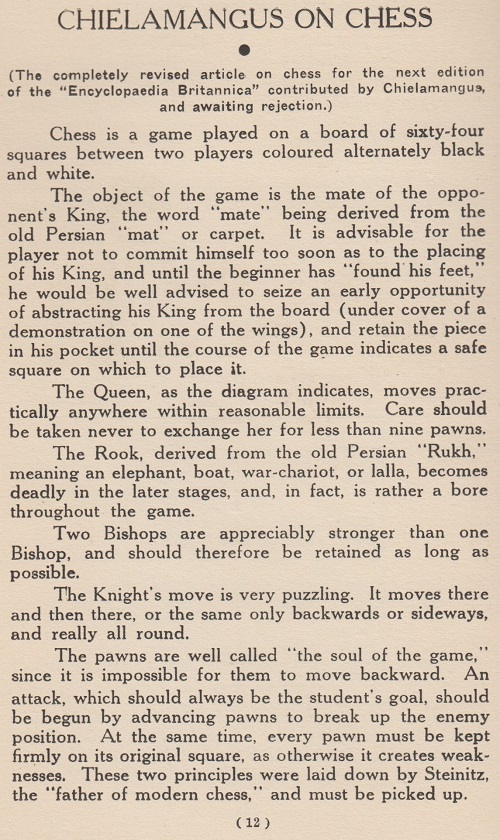
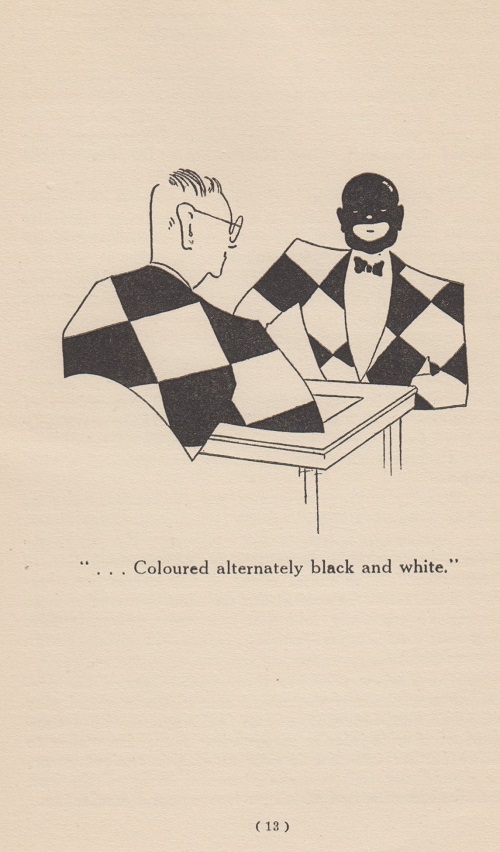


The concluding part of the Chielamangus article was a spoof history of chess.
10974. A diablerie
L. Ross Jackson (Raumati South, New Zealand) reports that he recently acquired this original pen-and-ink drawing:
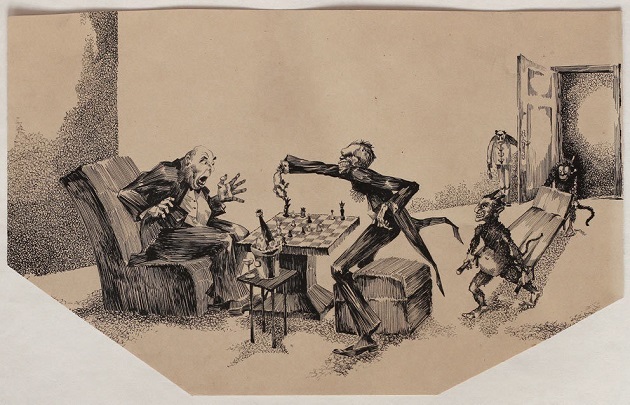
The dealer, in Vienna, had no information about the picture, which is unsigned.
10975. CHESS
By chance we have just been re-reading the October 2008 edition of CHESS (Editor: Jimmy Adams. Executive Editor: Malcolm Pein). Among the contents:
- Pages 5-15: a report by Raymond Keene on the Staunton Memorial tournament, which he had organized. Page 7 included, without sources, a biographical feature on Staunton which was a copy-paste from previous writings of his;
- Page 16: a full-page letter (about 180 lines in three
columns) dated 19 May 2008 from Raymond Keene to Kate
Hoey MP. ‘I am writing to you now to suggest that we
should revive the tradition of the annual London
Grandmaster Tournament ...’ ‘My preferred route would be
to invite you to lunch at Simpsons in the Strand ...’ An
editorial note on page 15 stated that the letter (copied
to the Mayor of London, Boris Johnson) had received no
reply, after three months;
- Pages 17-18: a flattering report on the Staunton Memorial tournament by Sean Marsh, ending with a banner advertisement for Raymond Keene’s website;
- Page 38: a 35-line article by Raymond Keene, ‘Chess versus Alzheimer’s’;
- Pages 47-52: ‘Sean Marsh interviews GM Raymond Keene OBE.’ Sycophancy (‘Your knowledge and experience of chess literature is [sic] absolutely immense ...’), with not a single probing/challenging question.
About 20 pages ...
10976. Interviews with Fischer and Spassky in 1972
Have recordings survived of the ‘first post-match interviews’ with Fischer and Spassky conducted by Gligorić for Radio Belgrade?
A report by Dragoslav Andrić on pages 2-3 of CHESS, October 1972 had transcripts, including these exchanges:
Gligorić: ‘Will you be making propositions concerning possible changes in the procedure of the world championship?’
Fischer: ‘I would not like to say anything definite just yet. For the time being, I want to play a few matches. Money is there and I want to make it.’
Gligorić: ‘Perhaps you would like to play Spassky again.’
Fischer: ‘Sure. If the purse is big enough, we will certainly play a return match.’
10977. Lasker’s voice
A question asked by Dale Brandreth (Yorklyn, DE, USA) in C.N. 938 (see pages 122-123 of Chess Explorations) remains unanswered: do any recordings exist of Emanuel Lasker’s voice?
10978. Front-page news and advertisement
Further to the articles Chess as Front-Page News and Chess in Advertisements, Avital Pilpel (Haifa, Israel) writes:
‘The front page of La’Merhav, 27 October 1957 has been brought to my attention by Moshe Roytman:
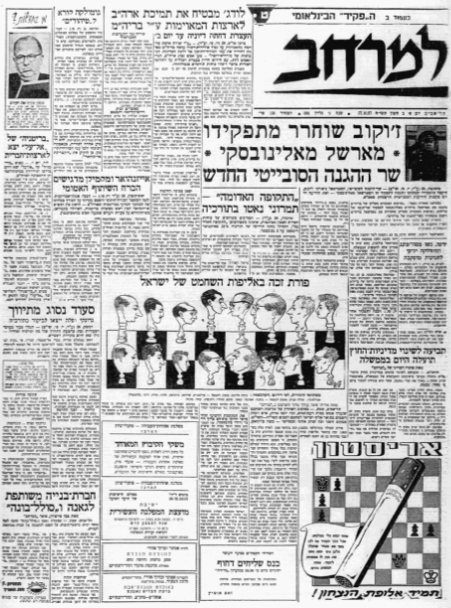
The caricatures by Buchwald are of all the players in that year’s national championship, in Tel Aviv, and below it is an article about the tournament by Eliyahu Fasher. The headline reads, “Porat won Israel’s chess championship”.

The players are (top row, from right to left) Pilschik, Kraidman, Czerniak, Aloni, Porat, Dyner, Blumfeld, Smiltiner and (bottom row, from right to left) Buchner, Etinger, Shaki, Kahane, Atidi, Rosenberg, Shahar, Binur.
The advertisement is for Ariston cigarettes, and the text explains why the position – after “Black has just conquered a piece with his queen” – is stalemate.’
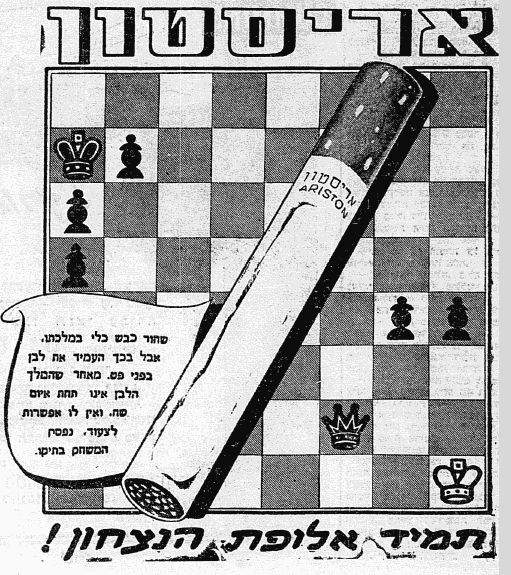
10979. Theory and practice
C.J.S. Purdy, writing on page 31 of the Australasian Chess Review, 27 February 1937:
‘Theory takes you further in chess than in any other game – but it does not take you all the way. What counts, above all, in practical play, is the ability to see mechanically and without effort all the “little combinations” that cloud the strategical issue. The master in constant practice can do this, where the amateur has to ferret them out laboriously, and occasionally misses them altogether, and then a blunder results. In tennis, cricket, etc., at least 80% of a player’s skill is purely mechanical – developed simply by assiduous practice. And in chess, although the percentage may be very much smaller – since intelligence and the ability to reason play much bigger parts than in other games – it is still quite large.’
10980. George Koltanowski
Feature articles about bas de gamme chess writers can only scratch the surface, usually examining their books rather than, even more masochistically, their routine ‘journalism’. Most of Koltanowski’s output that we have seen comes from his anthologies; the thought of trawling through old newspapers for the run of his syndicated columns is unappealing.
Koltanowski’s books ought to contain the cream of the crop, but they have far too many untrue or unauthenticated yarns to be accommodated in an article such as Koltanowski. Here, we add a passage regarding Akiba Rubinstein from page 126 of With the Chess Masters (San Francisco, 1972):
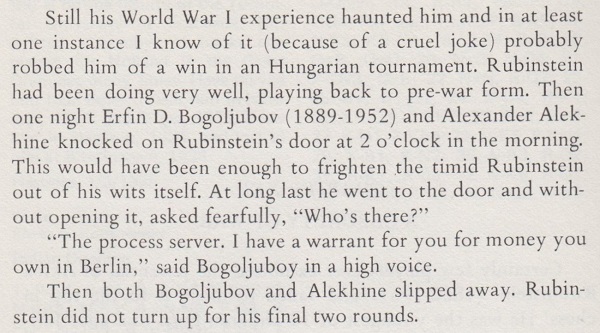
The story was reproduced on page 3 of Akiba
Rubinstein: The Later Years by J. Donaldson and N.
Minev (Seattle, 1995) with, generously, silent corrections
to Koltanowski’s spelling, grammar and punctuation. It was
then demolished.
10981. Photographs from L’Echiquier (C.N.s 10814 & 10836)
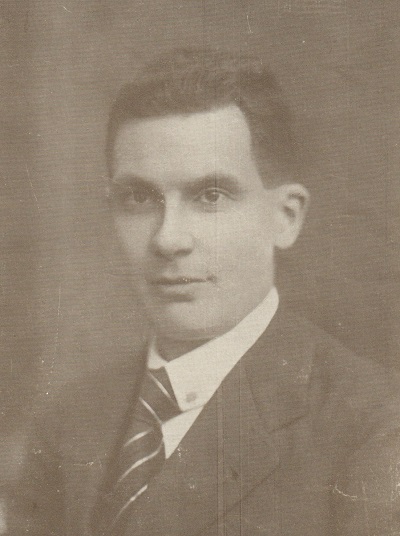
Alberto Mari, L’Echiquier, November 1926, opposite page 220

Max Nebel, L’Echiquier, May 1930, opposite page 768.
10982. Maxwell Bukofzer
From opposite page 716 of L’Echiquier, September 1927:

As reported in C.N. 3571, the chess composer Maxwell Bukofzer wrote a number of Sherlock Holmes stories with a chess theme.
10983. Purdy on Spassky v Fischer
The inside front cover of the October 1972 CHESS stated that three books on the Spassky v Fischer match, by Alexander, Gligorić and Horowitz/Reshevsky, ‘were on sale in Britain within a fortnight of the close of play’. Alexander’s was considered the best: ‘There is ten times as much really original analysis as in the other two books put together.’
A letter from C.J.S. Purdy dated 22 October on pages 45-46 of the November 1972 CHESS commented:
‘I question your remark that there are three books in English on the Reykjavik match. There is a fourth, How Fischer Won, by me (echo of my 1935 book How Euwe Won). Fantastically, it was already out of print (a 14,000 edition) when your October number appeared. It went out of print in one week. The only batch sent to Europe was 100 copies airfreighted to Skopje. They did not arrive and have not yet been traced. A much revised and augmented version will have been printed when you receive this, re-titled Genius Crowned.’
We are aware of no publication by Purdy of that name.

Purdy brought out an eight-page supplement, Post-Mortem 1976 to Fischer-Spassky 1972. A sample page:
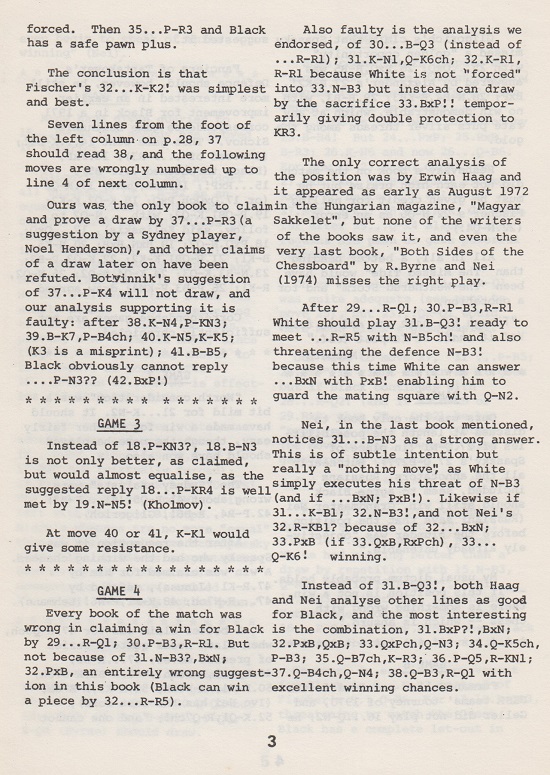
His remarks in CHESS about the print-run for How Fischer Won have prompted our latest feature article, Chess Book Sales.
10984. Proposed reform of the stalemate rule
Concerning stalemate, C.H.O’D. Alexander wrote on page 10 of Fischer v. Spassky Reykjavik 1972 (Harmondsworth, 1972):
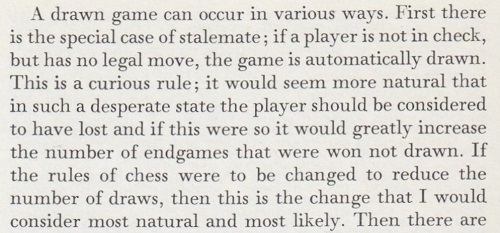
In a letter on page 160 of CHESS, March 1973 T.D. Harding disagreed. Paul V. Byway disagreed with him on page 230 of the May 1973 issue, and Alexander wrote on page 258 of the June 1973 edition:
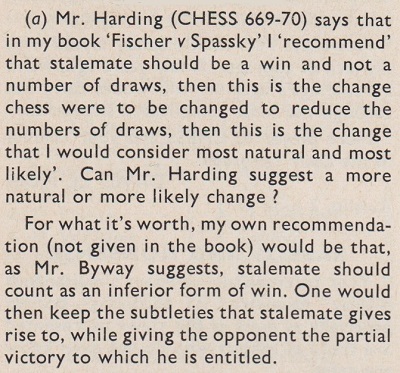
C.N. 7051 showed an account by Paul H. Litwinsky (later Paul H. Little) of an ‘offhand remark’ by Capablanca during the Nottingham, 1936 tournament:
‘He proposed to abolish the stalemate rule, saying that it is illogical.
His point was that often a player has a material superiority, such as two knights against a solitary king, or rook’s pawn and king against king, and yet is unable to win because of the stalemate. Capablanca’s suggestion was to give to the player with the material superiority two-thirds or three-quarters of a point ...’
10985. Gerald Abrahams
From the English-language Wikipedia entry for Gerald Abrahams:
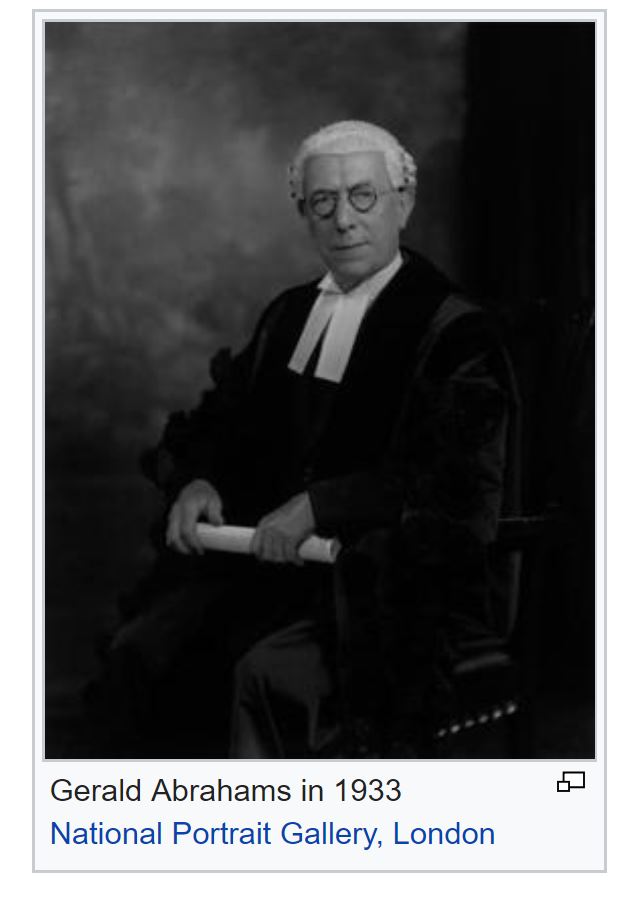
See too the National Portrait Gallery’s Gerald Abrahams page, which has a number of similar shots, all dated 21 August 1933.
At that time, Abrahams was aged 26.
10986. Capablanca in Buenos Aires, 1914 (C.N. 10951)
Another game annotated by Irving Chernev in The Golden Dozen was Capablanca v Villegas. From page 294:
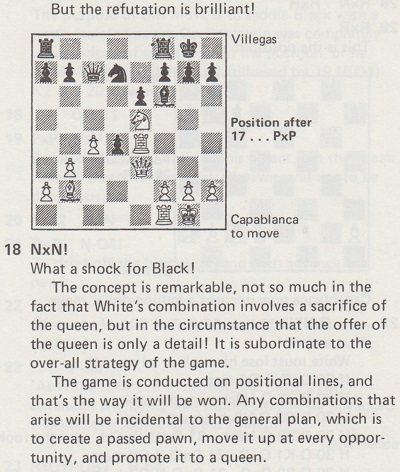
Chernev also annotated the game in Logical Chess Move by Move.
Below are the loser’s notes, from pages 78-79 of the Revista del Club Argentino de Ajedrez, July-September 1914:
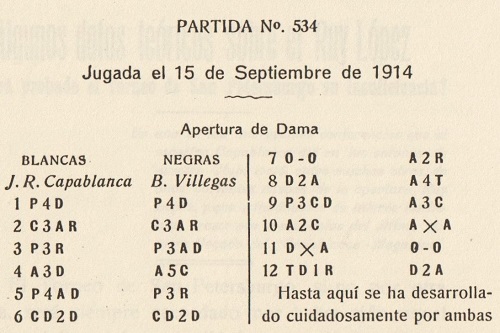
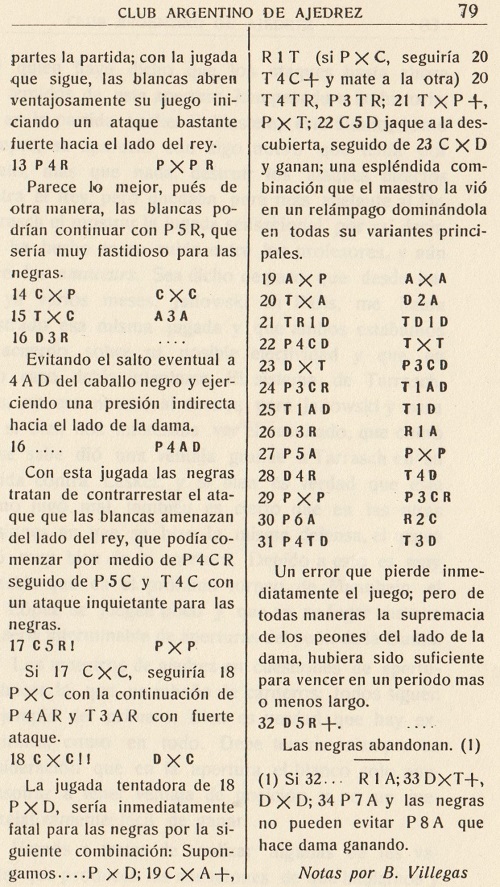
Although the heading states that the game was played on 15 September 1914, page 58 of The Unknown Capablanca by David Hooper and Dale Brandreth (London, 1975) had 19 August 1914, it being specified on page 199 that the score had been published in La Prensa, 23 August 1914.
10987. Fischer’s royalties
With regard to chess book sales, the University of Massachusetts Amherst holds a memorandum dated 29 November 1972 written by Mark H. McCormack, the founder of the International Management Group. He had been informed by Stanley Rader of receipt of ‘$200,000 in royalties since the Iceland chess match on Bobby’s eight-year-old book’.
The respective publication dates of Bobby Fischer Teaches Chess and My 60 Memorable Games were 1966 and 1969.
10988. Eley v Pachman (C.N. 7663)
C.N. 7663 gave a photograph taken during Brian Eley’s well-known victory over Ludĕk Pachman at the Evening Standard London Chess Congress in 1972. The newspaper had a half-page tournament report on page 6 of its 16 December 1972 edition:
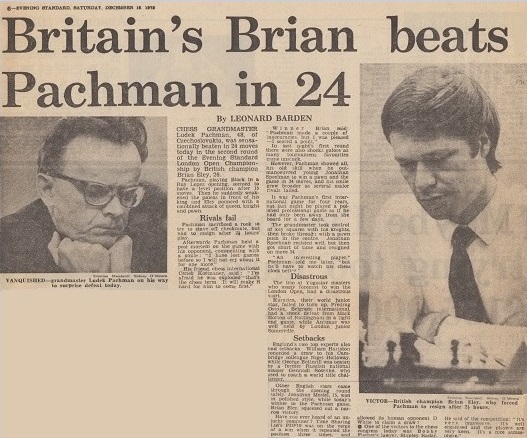
Stanley Rader (Fischer’s lawyer), who was mentioned in the previous C.N. item, was also referred to at the end of this Evening Standard report. He had visited the tournament and described it as ‘very impressive’.
| First column | << previous | Archives [169] | next >> | Current column |
Copyright: Edward Winter. All rights reserved.
